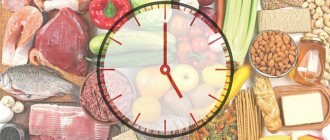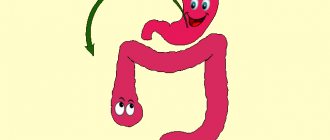>Dyspepsia or indigestion
- the most common reason for visiting a gastroenterologist. Symptoms of the disorder can be independent or associated with food intake and physical activity. Dyspepsia can occur against the background of diseases, and it is also often caused by the influence of factors such as poor diet, stress, and taking certain medications.
Signs of indigestion
Symptoms of dyspepsia are:
- discomfort or pain in the epigastrium;
- heartburn;
- belching;
- feeling of quick satiety;
- nausea;
- flatulence
We have prepared for you a list of studies that will help you deal with this problem:
90 working days
Panel “Inherited metabolic disorders”
35000 ₽
More details
30 working days
Panel “Hereditary diseases of the gastrointestinal tract”
22750 ₽
More details
7 working days
Analysis of c.-13910C>T polymorphism associated with lactose metabolism
1300 ₽
More details
Dangerous symptoms and conditions
Vomiting in infants is life-threatening
Vomiting of undigested food can be a symptom of a dangerous pathology that threatens the child's life. Parents need to monitor for other pathological manifestations in order to promptly suspect a condition requiring emergency care.
Danger signs include:
- Fever with high body temperature.
- Acute pain in the abdomen.
- Impaired consciousness in a child: lack of reaction to the environment, speech impairment, stupor.
- Severe weakness.
- Muscle cramps.
In addition to general dangerous symptoms, there are special criteria for emergency conditions in children of different age groups. Danger signs in children under six years of age:
- Simultaneous occurrence of vomiting and diarrhea.
- A sharp release of vomit.
- The appearance of symptoms of dehydration: wrinkled skin, dry mouth, irritability, weak pulse, impaired consciousness.
- Continuous vomiting for two to three hours.
- Body temperature is above 38 °C.
- Lack of urination for several hours.
Danger signs in children over six years of age:
- Vomiting during the day.
- Body temperature is above 39 °C.
- Signs of dehydration and impaired consciousness.
- Severe headaches.
- The appearance of blood in the vomit.
- Rapid heartbeat and shallow breathing.
Vomiting can be a sign of meningitis and other acute infectious pathologies that can cause significant harm to health.
Causes and forms of indigestion
Among the prerequisites for dyspepsia are such as hasty eating (food is poorly chewed, digestive juices do not have time to secrete in sufficient quantities), overeating, and consumption of certain foods and drinks (containing carbon dioxide, sugar, caffeine). Dyspepsia can be caused by stress and physical activity immediately after eating. Digestive problems can be caused by NSAIDs.
Indigestion can be caused by medical conditions. Half of the patients complaining of dyspepsia suffer from peptic ulcers or gastroesophageal reflux disease. Pancreatitis, cholecystitis, cholelithiasis, tumors of the stomach and pancreas also cause characteristic symptoms.
Organic dyspepsia (which is caused by certain diseases) differs from functional dyspepsia in the seasonal nature of pain, night pain (passing after eating), episodes of intense heartburn (at least twice a week), weight loss, etc.
Functional dyspepsia
is indigestion, which is accompanied by characteristic complaints against the background of a person’s general satisfactory condition and is characterized by a favorable course of the disease without progression. Such a disorder can occur due to psycho-emotional stress, irregular eating patterns, smoking, alcohol consumption, H. pylori infection, and the influence of unfavorable external factors.
Diagnosis of dyspepsia
If you complain of indigestion, you should contact a gastroenterologist or therapist.
In order to diagnose problems with digestion of food, the doctor gives a referral for examination:
- fibrogastroduodenoscopy;
- Ultrasound of the gastrointestinal tract;
- test for H. pylori;
- intragastric pH-metry;
- blood and stool tests;
- study of gastroduodenal motility.
Symptomatic therapy
If vomiting occurs once or occasionally and is caused by overeating, it does not require specific treatment. To reduce the load on the digestive system after heavy feasts, it is advisable to eat easily digestible low-calorie foods for several days and refrain from eating fatty meat dishes and smoked meats. If you suspect food poisoning, you should rinse your stomach and take sorbents. For gastrointestinal pathologies, complex therapy of the underlying disease is necessary.
Until an accurate diagnosis is made, medications can be used to reduce unpleasant symptoms: prokinetics, anticholinergic drugs. You should not take strong antiemetics on your own, as this can be dangerous to your health. Repeated vomiting of food, which is accompanied by a disturbance in the general condition, an increase in body temperature, and the appearance of pathological impurities of blood or bile in the liquid vomit, is an indication for immediate medical attention.
Treatment of indigestion
For patients with dyspepsia, an individual dietary regimen is recommended. It is necessary to exclude or reduce individually intolerant foods in the diet. If you have indigestion, it is recommended to stop smoking and drinking alcohol.
For dyspepsia, the following drugs are prescribed:
- prokinetics
(means to normalize the motor function of the gastrointestinal tract); - antibiotics
(eradication therapy is carried out to combat H. pylori); - antacids
(neutralize the increased secretion of hydrochloric acid in the stomach).
To alleviate the patient’s condition with dyspepsia, the following measures are also recommended:
- diet correction
(in the acute phase of indigestion, fasting for 1–2 days is indicated, then you must follow a therapeutic diet); - taking medications with enzymes
(pepsin, pancreatin, etc.); - therapeutic exercises
to improve gastrointestinal motility, abdominal massage.
Possible causes of vomiting
A child's vomiting of undigested food may be due to banal overeating
Nausea and vomiting are caused by stimulation of special brain centers responsible for the functional activity of the digestive organs. Normally, this is a natural protective reaction of the body to the entry of allergens, intolerable foods and harmful substances into the stomach.
However, no less often, vomiting becomes a kind of side effect of severe stress, overexcitation of the vestibular apparatus and other conditions not related to digestion.
Possible causes of vomiting largely depend on the age of the patient. In children, this symptom is most often caused by a viral infection, food poisoning, milk allergy, motion sickness and overeating during feeding. Additional symptoms may indicate the real source of pathology.
More details about the reasons:
- Gastroenteritis is an infectious disease of the intestines. Vomiting may not stop for several days. Other symptoms include abdominal pain and loss of appetite.
- Allergy to food. The condition is easily identified by other, more severe symptoms, including facial redness, skin rash (hives), itching, and swelling around the eyes and lips.
- Infections of other organs. Vomiting can also occur with urinary tract infections, otitis media, pneumonia and meningitis. Fever, which is an important clinical sign of an acute infectious disease, itself causes vomiting.
- Appendicitis is an inflammatory disease of the appendix of the large intestine. In addition to vomiting, it causes severe pain in the abdomen on the right and increased body temperature.
- Accidental ingestion of a toxic substance. Out of curiosity, a child may drink vinegar or detergent, causing profuse vomiting. Poisoning with such substances is extremely dangerous and requires immediate medical attention.
- Food intolerance – problems with the absorption of lactose, gluten or other substances, manifested by nausea, vomiting and diarrhea.
- Gastroesophageal reflux is the reflux of stomach contents into the esophagus due to disruption of the lower esophageal sphincter.
- A strangulated hernia is a surgical emergency.
- Congenital pyloric stenosis is a pathological condition characterized by narrowing of the stomach. Food is difficult to transport into the intestines, resulting in vomiting.
Vomiting of undigested food only indicates that the disease arose before the reflux of food substrates into the small intestine. This sign does not always indicate poisoning or food intolerance.
It is important for a parent to know that one of the main diagnostic criteria for food poisoning is vomiting that occurs 1-8 hours after the last meal. However, many bacteria (for example, salmonella) can cause less specific signs of food poisoning.
Preventing indigestion
The normal functioning of the digestive system requires compliance with the following rules:
- healthy eating to prevent indigestion
(refusal of strict diets, balanced composition of proteins, fats and carbohydrates, consumption of vegetables and fruits in sufficient quantities, exclusion of fast food, etc.); - getting rid of bad habits
(frequent drinking of alcohol, eating dry food, eating on the go, overeating at night, not having breakfast); - developing an adequate response to stress
(indigestion is often associated with negative emotions and nervous tension).
Measures to prevent dyspepsia also include proper rest, healthy sleep, and sufficient physical activity.
You can get tested for a tendency to gastrointestinal diseases, including indigestion, at the Medical Genetics Center.
How to achieve maximum absorption of food so as not to eat in vain - Om Activ
- Per 22 chewing movements, do one swallow.
Saliva also produces mucin, a substance that helps food gently slide down the esophagus into the stomach.
In order for enough mucin to be produced, you need to make at least 20 jaw movements. In addition, even at the level of the oral cavity, the body begins to recognize the composition of food and prepare the appropriate enzymes in the required quantities in all parts of the digestive system!
The longer food is in the mouth, the lower the risk of poisoning. The fact is that saliva contains lysozyme, a substance with a bactericidal effect.
Mix foods that are similar in speed of digestion.
Products differ from each other in the time it takes to digest them. The body digests an apple in 30-45 minutes, and hard cheese in 4-6 hours.
Therefore, try to mix foods from the same group before eating.
First group: up to 45 minutes (mainly carbohydrates).
● Fruits (watermelon, grapefruit) - 30 minutes; ● Cherry, apple, peach - 40 minutes; ● Vegetables (raw) - 30-45 minutes; ● Broths, fruit salads - 30 minutes; ● Juices from vegetables and fruits - 15-20 minutes.
Second group: up to 2 hours (mainly protein foods with a small amount of fat).
● Egg - 45 minutes; ● Low-fat fish—30 minutes; ● Fatty fish – 45 – 60 minutes; ● Chicken - 1-2 hours.
Third group: 2-3 hours (mainly foods containing complex carbohydrates and starch).
● Potatoes; ● All porridge; ● All mushrooms; ● Cottage cheese (only from whole milk) - 125 minutes; ● Seeds (sunflower, sesame) - about 2-3 hours; ● Nuts – 2.5-3 hours; ● Legumes.
Fourth group: 3-4 hours or more.
- Most of them often do not have time to be completely digested and are excreted from the body in this form.
● Coffee and tea with milk; ● Smoked fish and canned fish; ● Meat and its semi-finished products - at least 3-4 hours; ● Hard cheese - 4-6 hours; ● All types of pasta (in addition to products made from durum wheat).
Mixing products from the same group (vegetable salad, apples and pears, carrot and beet juice) will only slightly extend the time the food stays in the stomach due to the difficulty of selecting enzymes for processing, but this mix option is acceptable.
But we do not recommend mixing products from different groups.
For example, you ate nuts with fruit. The rate of absorption of the dish immediately increases due to difficulties in selecting enzymes. Moreover, some fruits will remain in the stomach for the entire 2-3 hours along with nuts, because the body simply will not be able to send them to the intestines. Some, of course, will “fall through” further, but be sure to take with them the not yet processed nuts. And in the intestines there are not many disposal options for them: rot or ferment.
Don't drink it
When we drink water on an empty stomach, the stomach reflexively pushes it further into the intestines. And if there is food in the stomach at this time, unprocessed food also slips in with the water. Water also dilutes the gastric juice, and the breakdown of foods slows down again.
- Drink 30 minutes before meals and 2 hours after.
Raw foodists can safely shorten this gap, because the processing speed of their food is much lower.
Choose gentle food processing
Boiling and frying destroy the enzymes found in raw food and also destroy its original structure. Such dishes are usually digested 1.5 times longer and worse. Steam or bake - we wrote about it here.
Consider meal times
The body works most actively during lunch - at this time you can eat foods with the maximum digestion period. During breakfast and dinner, food is not digested so quickly, so for breakfast and dinner you need to eat foods at the same digestion time and with the maximum speed of absorption.
Make sure you have enough enzymes
We have already mentioned that enzymes are found in food itself, mainly in plant foods and only in raw foods. Therefore, eat as many fresh vegetables as possible.
Pancreatic enzymes are AMINO ACIDS + a vitamin or mineral. Therefore, a complete protein (amino acid) diet and the presence of minerals and vitamins in the diet will provide you with the potential to form the necessary enzymes.
If you understand from symptoms (discomfort, heaviness, bloating, unpleasant persistent odor, greasy stool, etc.) or tests that there are not enough enzymes, use an enzyme complex!
Normalize the flow of bile
Normalization of the outflow of bile and a sufficient amount of it will allow the digestion and absorption of fats.
To do this you need:
● drink enough water, ● consume healthy fats , ● include choleretic products and choleretic herbs in your diet (if contraindicated).
If stool is poorly flushed from the ceramics of the toilet, then you have difficulty digesting and absorbing fats. Most likely due to insufficient bile processing.
Restore intestinal microflora
The final function of digestion and assimilation is taken over by the microflora.
- The amount of absorbed minerals increases 4 times with the correct balance of intestinal microflora!
If you have frequent constipation, intestinal disorders, bloating on fruit peels, take a probiotic complex!
- The minimum you can do daily is consume fermented milk products!
Microflora also contributes to the restoration of the intestinal mucous surface, the regeneration of villi, through which the adsorption of substances ultimately takes place!
Eliminate chronic constipation!
When feces accumulate in the small or large intestine, the amount of food digested will be minimal.
Basic solutions:
● sufficient amount of water and fiber, ● normalization of the gallbladder, ● good microflora (see above), ● calm thoughts!)
We provide you with general guidelines, knowledge and objective recommendations for better digestion and absorption of food. But remember that if anything in the gastrointestinal tract system confuses you for a long time, do not hesitate and contact a specialist!










